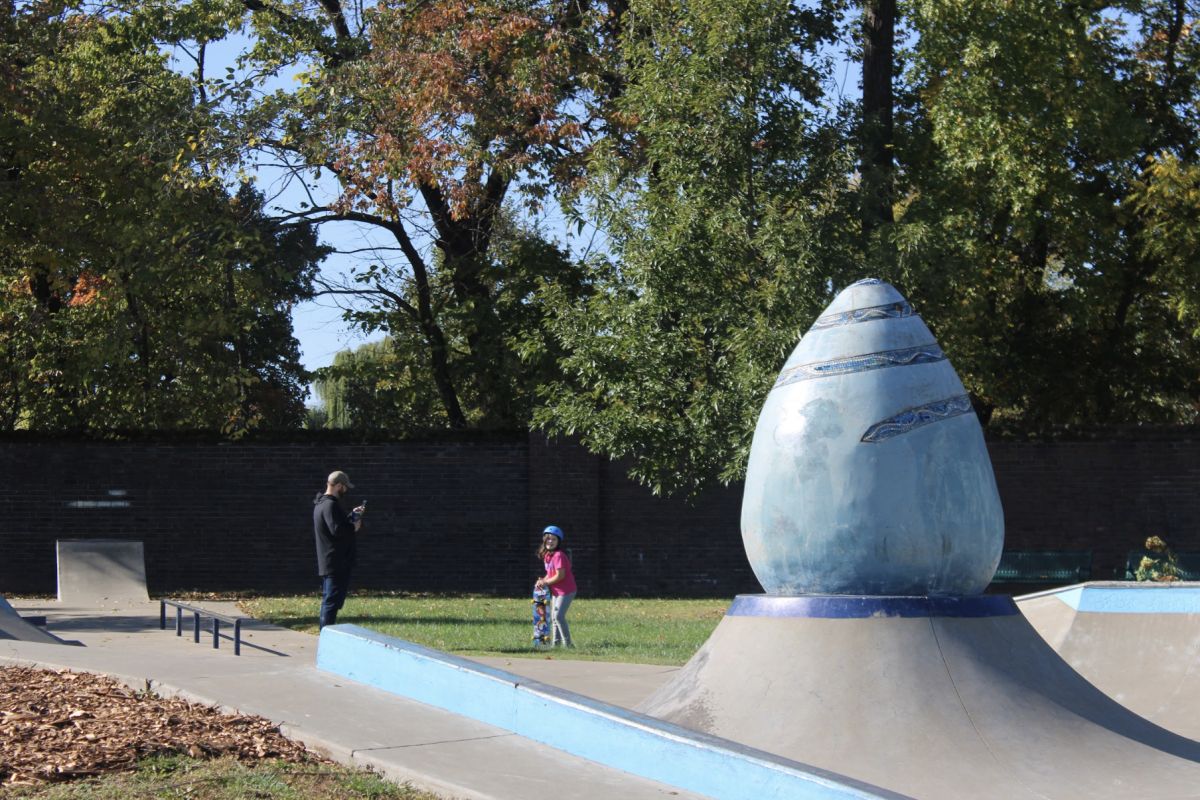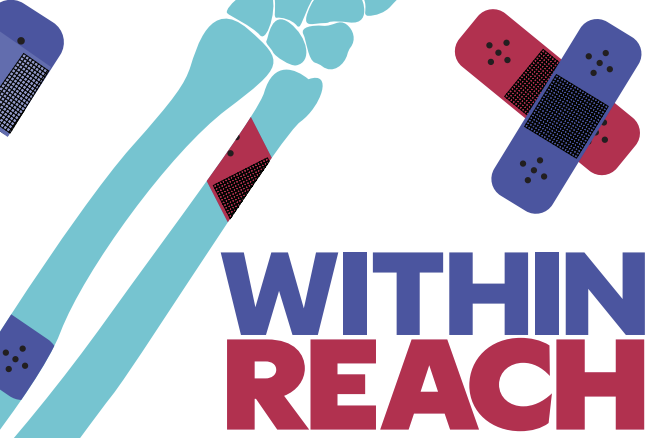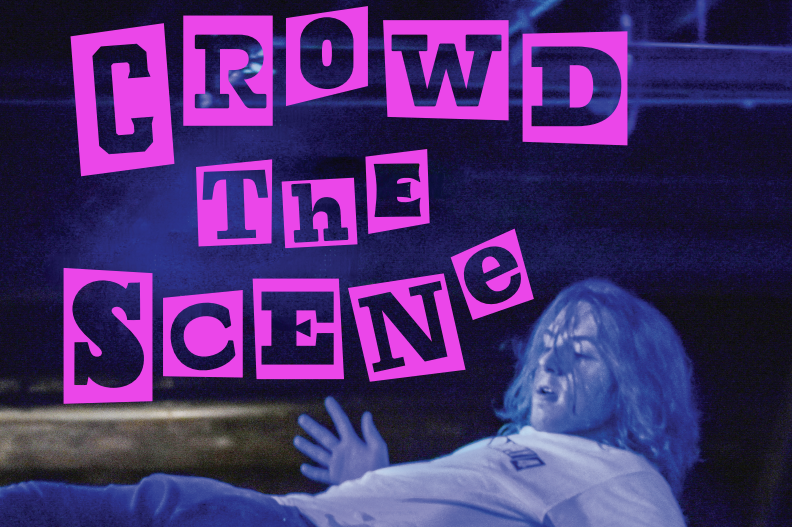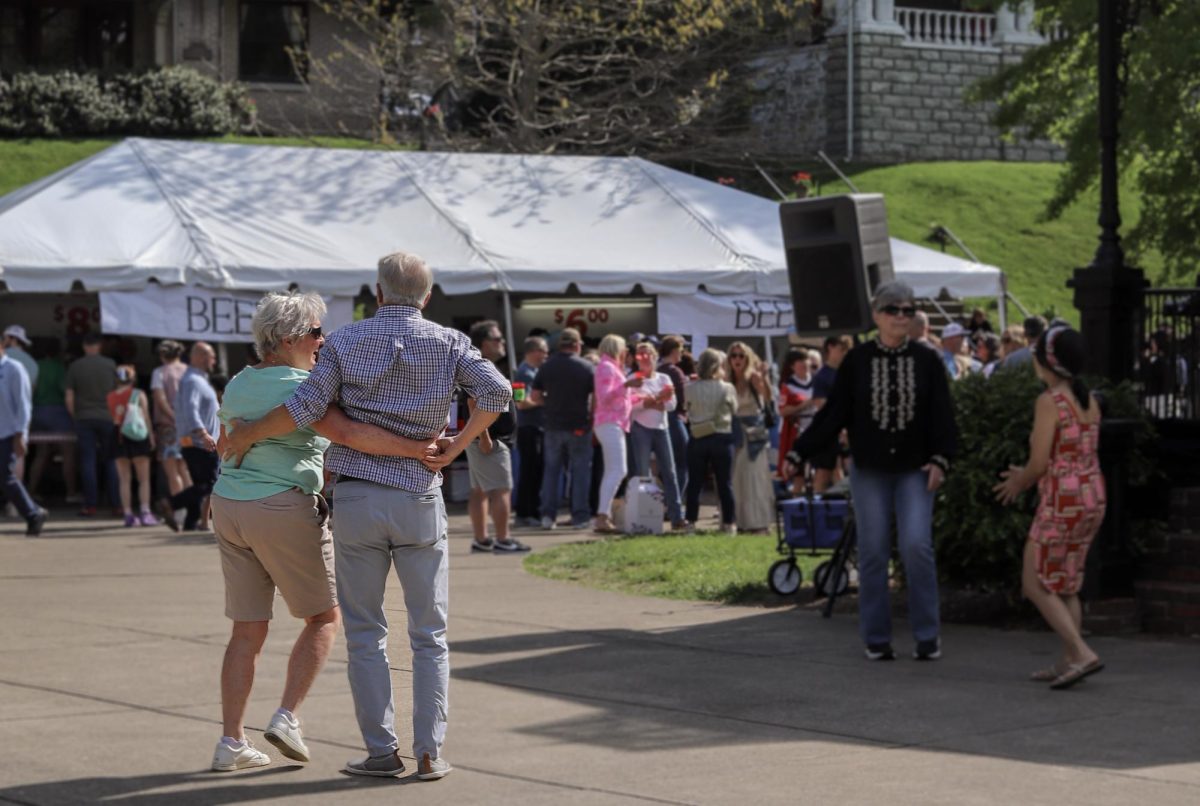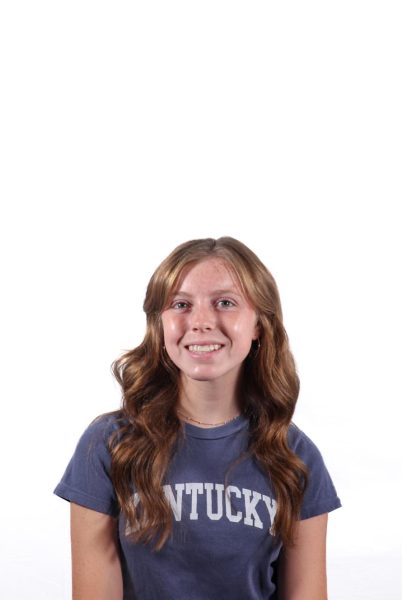writing by LUCY VANDERHOFF • design by MALI BUCHER
I stepped onto the short path through William Harrison Park, located in the Taylor Berry neighborhood of west Louisville. It was a sunny, cloudless October day, and I couldn’t help but notice how different it was from the parks I grew up going to, which were predominantly well-funded and in the East End, where property values are generally higher. It was much smaller, with the bare pavilion just mere feet from the defunct splash pad, only a few steps from the playground. Taking up the left half of the park, though, was one of the nicest public turf fields I’d ever seen.
This field was a recent project of the Parks Alliance of Louisville, a nonprofit
that aims to bring equitable investment and access to parks across the city. Before this, there had been no public turf fields in south Louisville.
But as I approached the field, installed just over four years ago, I couldn’t help but notice the rundown nature of the park. There were overgrown weeds at the base of the bleachers next to the pristine turf, cracks on the small basketball court, and weeds growing up the park fence.
I expected to find a similar lack of upkeep in some of the other smaller, city-funded parks I visited, but I was pleasantly surprised. At Breslin Park in the eastern Irish Hill neighborhood, a young man was weeding the plant bed
next to the Parks Alliance-funded skatepark. At Russell Lee Park in the Park DuValle neighborhood in the West End, large paths sat free of litter and weeds alongside the Parks Alliance’s “pop-up” nature play amenity, an installation for kids to play with and discover nature through logs, rocks, and stumps.
I’m not the only one who noticed that a divide has opened between parks acr
oss the city. Brooke Pardue, president and CEO of Parks Alliance of Louisville, noticed this gap widening, especially during COVID-19.
“We realized that there was no way that we were going to ‘Whac-A-Mole’ our way out of decades of systemic disinvestment in our public parks,” Pardue said.
So she took inspiration from outside of Louisville’s limits and looked to peer cities, or cities with a similar population.
“I had been to a conference in November of 2019, talking about work that had been done in Minneapolis and Pittsburgh around park equity and doing a thorough analysis,” Pardue said.
She decided a similar project could be the way to jumpstart Louisville’s shift toward equitable parks.
“We worked at raising the money, getting everything lined up, and we launched the Parks for All initiative in August of 2021,” Pardue said.
Parks for All is a comprehensive analysis of every aspect of parks: investment, health in the area, what residents want, and much more. The Parks for All initiative published its final report in January 2023. Pardue was not surprised by the disinvestment, but rather the extent of it.
“I think the level to which we have not been serving our underserved communities, the level to which we have not invested in low-income community parks and low-income communities of color where the benefits of quality parks are most needed was still shocking to me,” Pardue said.
These disparities became even more evident when examining the source a
nd distribution of funding.
The Louisville Parks and Recreation department manages 120 parks. Along with city funding, 17 of these parks receive additional money through the Olmsted Parks Conservancy, a nonprofit founded to preserve and maintain the parks, which were designed by famous landscape architect Frederick Law Olmsted. Another nonprofit, Wilderness Louisville, supports natural areas such as forests and swamps and provides additional funding for 13 more parks. Two parks, Shawnee and Chickasaw, receive supplementary funding from both organizations.
“We provide an extra layer of care for our parks,” said Layla George, president and CEO of the Olmsted Parks Conservancy.
The funding from the Olmsted Parks Conservancy and Wilderness Louisville
assists with upkeep, events, and preservation, but only a fraction of Louisville’s parks benefit from this kind of extra support.
While these organizations help with the upkeep of these parks, the limited funding distribution creates a greater imbalance in the quality of parks across Louisville. This is what the Parks Alliance of Louisville aims to fix, but it hasn’t always been their focus.
The Parks Alliance of Louisville started as the Louisville Parks Foundation, tasked with acquiring land for Jefferson Memorial Forest. Over time, the organization was rebranded with a wider mission to increase investment in all parks across the city.
Despite extra help from three of these different nonprofits, Louisville faces a citywide lack of funding for parks. Parks Alliance of Louisville found that, in 2019, the Louisville Metro Government spent just $43 per resident on parks, while peer cities spent an average of $118 per resident. This brings down the quality of parks across Louisville and is why nonprofits like Olmsted Parks Conservancy and Wilderness Louisville exist in the first place.
The report also noted that, since 2004, 15 of the Olmstead Parks have received
a total of $38.4 million in funding, while in the same period, 103 other Louisville parks have received just $42.1 million to split amongst them. In less than 20 years, those 15 parks received almost half of the total funding allocated to all Louisville parks.
To address the inequity in funding, the Parks Alliance is taking steps to provide resources and improve the poor conditions they identified in the report. Alongside their report, they published an action plan.
The plan identified four different areas of investment for the city to focus on: maintenance, rehabilitation, capital improvements and recreational programming. In a survey conducted across Louisville households, 38 percent of residents said their main concern was rehabilitation, with maintenance coming in second at 33 percent. Therefore, Parks For All determined rehabili
tation as their top priority.
The plan also called for more city funding, which the Louisville Metro Council and Mayor Craig Greenberg delivered on when they approved a 25 percent increase in the Louisville Parks and Recreation Department’s annual budget this past June.
“This mayor is committed to funding our public park system,” Pardue said.
Mayor Greenberg planned to draw these funds from the American Rescue Plan (ARP), a national plan working to provide financial stimulus following the COVID-19 pandemic. Louisville Metro received $388 million from ARP and identified six priority areas for the funds.
One of these priorities, “Healthy Louisville/Healthy Neighborhoods,” receive
d a $63 million share of Louisville’s ARP funds. This money went toward projects to improve access to healthcare and childcare, along with the neighborhood environments for all residents. Mayor Greenberg wanted to include parks as part of the priority area, and on Nov. 18, he described this plan at a park opening sponsored by the Parks Alliance.
“I’ve asked my council colleagues on Metro Council to support my proposal to redistribute $14 million of American Rescue Plan funding to invest in much needed deferred maintenance consistent with the Parks for All plan across our city,” Mayor Greenberg said.
On Dec. 19, Mayor Greenberg announced that $10 million of ARP funds would be distributed to Louisville Parks and Recreation for projects across the city. While this wasn’t the full amount he asked for in his proposal, it would still aid in park renovation.
Aside from budgeting and funding plans, the Parks for All report identified which neighborhoods and parks should be prioritized in aid allocation. It not only looked at a park’s amenities and condition, but at the characteristics of the surrounding area. Historically less affluent neighborhoods, for example, would receive higher priority.
One site the Parks for All report recognized as a top priority was the California neighborhood, which is situated in west Louisville and is one of the lowest income areas in the city. In 2009, this area flooded and homes became uninhabitable. The Metropolitan Sewer District then received a grant which allowed them to bulldoze the homes as part of a flood mitigation effort. For much of this time, these 20 acres sat as nothing but a vacant lot. That is, until, the Parks Alliance and community partners began revitalizing the land, transforming it into the Alberta O. Jones Park.
The park opened on Nov. 18 and welcomes visitors with its multiple walking paths, event spaces, and playground. To include the local community in the design of the park, the Parks Alliance surveyed residents on what kind of features they would like to see. Many respondents wanted a playground that reflected the musical interest of the community. So the playground boasts
a climbing wall that resembles a musical scale, a bridge that looks like a xylophone, and giant chimes children can bang on. The park even hosts an outdoor classroom, one of the priorities identified by the community survey. Long-term plans include a large open field and a performance stage.
While one of the Parks For All initiative’s primary focuses is on solving the inequality in parks, Pardue also has passion for getting young people reconnected with nature. Park access is just as important as park equity.
“These children that are in these urban environments that don’t have access to quality time outdoors are paying the price in their mental, their physical, their emotional health,” Pardue said.
Pardue saw the importance of kids being outside, especially in a world that is so intertwined with technology.
“Child development requires children to be able to interact with one another, to work in a cooperative play environment, and to be in the natural environment,” she said. “We have gotten so far away from that, in our schools, in our lives.”
Adults aren’t the only ones seeing the value in quality park access — teens across Louisville travel to nicer parks, some having to snub the parks right next to them because of quality or maintenance issues and safety concerns.
Leni Logsdon, 18, lives just a short walk from Shelby Park, which is just southeast of downtown. However, when she wants to go to a park, she often finds herself driving about 15 minutes east to Seneca Park.
“I feel like, if it was a little more updated and the facilities were a little more secure, people would feel better going there,” Logsdon said.
Lena Jazi, 17, took a more open approach.
“I like to explore different kinds of parks because they’re all very different,” Jazi said.
In her exploration, she has noticed a few inequities across the city’s parks. Bec
ause of this, she has developed her favorites and gravitates toward a few of the more well-funded parks like Seneca Park or Jefferson Memorial Forest, funded by the Olmsted Conservancy and Wilderness Louisville, respectively.
Pardue argues that investing in a park doesn’t just mean a fresher neighborhood playground or shiny tennis courts — it means a healthier and happier community. A new investment provides a new meeting spot, a place for exercise, and gleaming opportunities for all ages.
“Parks are not a ‘nice to have,’” Pardue said. “Like, ‘Oh, well, we have to have police and if we have any money left over then maybe we can throw it into our parks.’ It’s like, no, no, we need to be investing in our parks.”
Metro Louisville’s recent financial commitment to its parks shows that some city leaders share Pardue’s view. Moving ahead, the key will be to ensure they keep up the funding as politicians come and go, until Parks for All’s actio
n plan is completely implemented.
“Time will tell if we actually get the right people in place, and if this can be su
stained because it is a 15-year plan,” Pardue said. “We need to make sure one of our primary focuses is on continuing that momentum and basically holding people accountable to what they said.”
Perhaps, then, all of Louisville’s residents will have access to the knowledge, beauty, and power contained within parks.



